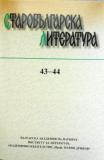Проблемы текстологии древнеболгарского перевода Хроники Георгия Амартола
Textological Problems of the Old Bulgarian Translation of George Hamartolos’ Chronicon
Author(s): Rostislav StankovSubject(s): Language studies
Published by: Институт за литература - БАН
Summary/Abstract: TEXTOLOGICAL PROBLEMS OF THE OLD BULGARIAN TRANSLATION OF GEORGE HAMARTOLOS’ CHRONICON ROSTISLAV STANKOV (SOFIA) (S u m m a r y) Textological problems of the early Slavonic translation of George Hamartolos’ Chronicon (Old Bulgarian in its origin) so far have been discussed in the studies of several scholars. In the beginning an attention is paid to V. A. Matveenko – L. I. Ščegoleva’s hypothesis that a collation of translation with the Greek original might have taken place. The analysis of Matveenko-Shchegoleva’s examples shows that there is no evidence for such a collation. Basically the study examines the textological method and main conclusions of V. M. Istrin and O. V. Tvorogov. The analysis reveals that all the eight Old Russian copies of George Hamartolos’ Chronicon in Istrin’s edition have common textual variants. Istrin’s division of copies into two groups (further subdivided into two versions) opposed to Tr (Troice-Sergieva Lavra 100) is dubious and far from reality. What is more, Istrin claimed closeness of Tr to the archetype of the translation of George Hamartolos’ Chronicon but even copies considered distant from the archetype of the translation have their original textual readings. Istrin’s stemma is to be considered artificial; it does not contribute to the further textological investigations of the early Slavonic translation of George Hamartolos’ Chronicon. As O. V. Tvorogov sayed, the textual variations of the early Slavonic translation of George Hamartolos’ Chronicon could not be considered as detached versions. Nevertheless, the scholar continued the tradition by using the term version (redakcija). In his studies Istrin’s stemma received further development and assumed more complicated form. Even more, Tvorogov even supposed a secondary textual influence upon a group of some Old Russian copies George Hamartolos’ Chronicon (A in his stemma) by the Second version of the Ellinskij Letopisec. Such a thesis is beyond proof. A special attention is paid to manuscript P (Pogodin 1432 from the Russian National Library in Saint Petersburg). It was written by several copyists. One of them in contrast to the others used Old and Middle Bulgarian orthographical features. The fact is significant enough to prove that P goes to the Old Bulgarian tradition of the early translation of George Hamartolos’ Chronicon. But none of the Russian scholars ever said a word about that. In the end of the study some theoretical notes on Mediaeval Slavonic textology were made. The long tradition of the early Slavonic translation of George Hamartolos’ Chronicon reveals a great chaos in textual readings witnessed by its Old Russian copies. In that situation a stemma does not make sense because the stemma is chaotic in itself. This could be seen in T. V. Anisimova’s stemma. It is beyond hope that the chaos in variant readings witnessed in the manuscripts will ever coincide with the chaos of the stemma, so that some kind of a real picture could be receiv
Journal: Старобългарска литература
- Issue Year: 2010
- Issue No: 43-44
- Page Range: 38-95
- Page Count: 58
- Language: Russian
- Content File-PDF

